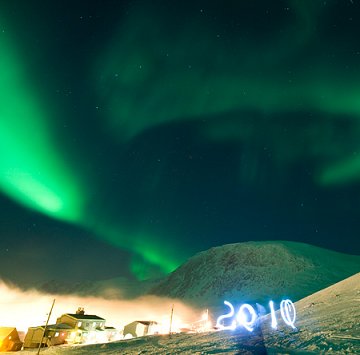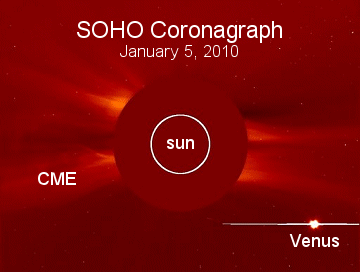
What's up in Space What's up in Space
January 6, 2010 6 gennaio 2010

SATELLITE FLYBYS APP: Turn your iPhone or iPod into a field-tested satellite tracker! SATELLITE flyby APP: Trasforma il tuo iPhone o iPod in un campo-prova tracker satellite! Spaceweather.com presents the Satellite Flybys app . Spaceweather.com presenta le app Satellite Fly-by.

SPACE STATION FLYBYS: The International Space Station (ISS) is flying over North American towns and cities this week. STAZIONE SPAZIALE flyby: La Stazione Spaziale Internazionale (ISS) è che sorvolano le città del Nord America e le città di questa settimana. It is very bright and easy to see in the night sky. È molto brillante e facile da vedere nel cielo notturno. Check the Simple Satellite Tracker to see if you are favored with a flyby. Verificare la semplice Satellite Tracker per vedere se vi sono favoriti con un fly-by.
flyby images: from Ed Sweeney in the Santa Cruz Mountains of CA flyby immagini: da Ed Sweeney nelle montagne di Santa Cruz di CA
FIRST AURORAS OF 2010: Last night, for the first time this year, the clouds parted over Pangnirtung, an Inuit village on Baffin Island in the Canadian Arctic, and the auroras came out to play: Aurore PRIMA DEL 2010: La notte scorsa, per la prima volta quest'anno, le nuvole si separarono nel Pangnirtung, un villaggio Inuit sull'isola di Baffin nell'Artico canadese, e le aurore è venuto fuori a giocare:

"Mild temperatures at this time of year created a heavy ice fog which blanketed the community, while the Northern Lights danced over head," reports photographer Claus Vogel . "A couple of kids came over to investigate what I was doing, and within a few minutes they were trying their hands at aurora photography. We even played with the flashlight to write 2010." "Mild temperature in questo periodo dell'anno, ha creato una nebbia di ghiaccio che ricoperto la comunità, mentre l'aurora boreale ballato sopra la testa", riferisce fotografo Claus Vogel. "Un paio di ragazzi che si avvicinò per indagare su quello che stavo facendo, e nel giro di pochi minuti stavano cercando le mani alla fotografia Aurora. Abbiamo anche giocato con la torcia a scrivere il 2010. "
The lights were sparked by a knot of solar magnetism that wafted past Earth in the solar wind. Le luci sono stati generati da un nodo di magnetismo solare che si spandeva Earth passato nel vento solare. The south-pointing magnetic field from the sun partially cancelled the north-pointing magnetic field of Earth. Il sud-puntamento campo magnetico dal sole parzialmente annullato la punta nord-campo magnetico della Terra. Solar wind poured through the breach and fueled the display. Vento solare versato attraverso la breccia e alimentato il display.
Says Vogel, "here's to more astronomical wonders in the year ahead!" Dice Vogel, "ecco a più meraviglie astronomiche l'anno a venire!"
NEW: January Northern Lights Gallery NOVITA ': gennaio Northern Lights Gallery
[ previous Januarys: 2009 , 2008 , 2007 , 2005 , 2004 , 2001 ] [Januarys precedenti: 2009, 2008, 2007, 2005, 2004, 2001]
SOLAR ACTIVITY: Yesterday, January 5th, something exploded on the back side of the sun and hurled a coronal mass ejection (CME) into space. Click on the SOHO image to see the billion-ton cloud in motion: Attività solare: ieri, 5 gennaio, qualcosa è esploso sul retro del sole e lanciò una espulsione di massa coronale (CME) nello spazio. Clicca sull'immagine per visualizzare il SOHO miliardi di tonnellate-nube in movimento:

The source of the blast was probably one of several regions currently located behind the sun's eastern limb. La fonte di l'esplosione è stata probabilmente una delle diverse regioni attualmente situato dietro bordo orientale del sole. NASA's STEREO-B spacecraft is monitoring three old sunspots there--AR1035, AR1036 and AR1038. STEREO sonda della NASA-B è il monitoraggio tre macchie vecchie lì - AR1035, AR1036 e AR1038. The emergent latitude of the CME best matches that of AR1036, which will turn to face Earth in a few days. Stay tuned for solar activity. La latitudine emergenti del CME migliori corrispondenze che di AR1036, che si trasformerà per affrontare la Terra in pochi giorni. Restate sintonizzati per l'attività solare.
more images: from Howard Eskildsen of Ocala, Florida Altre immagini: da Howard Eskildsen di Ocala, Florida
Explore the Sunspot Cycle Esplora il ciclo delle macchie solari








Near-Earth Asteroids Near-Earth Asteroids


Potentially Hazardous Asteroids ( PHAs ) are space rocks larger than approximately 100m that can come closer to Earth than 0.05 AU. Asteroidi potenzialmente pericolosi (PHA) sono rocce spazio più grande di circa 100 metri che possono avvicinarsi alla Terra di 0.05 UA. None of the known PHAs is on a collision course with our planet, although astronomers are finding new ones all the time. Nessuna delle note PHA è in rotta di collisione con il nostro pianeta, anche se gli astronomi stanno trovando nuovi tutto il tempo.

On January 6, 2010 there were 1091 potentially hazardous asteroids. Il 6 gennaio 2010 ci sono stati 1.091 gli asteroidi potenzialmente pericolosi.

Jan. 2010 Earth-asteroid encounters: Gennaio 2010 Terra-asteroide incontri:
Asteroid Asteroide
Date(UT) Date (UT)
Miss Distance Miss Distanza
Mag. Mag.
Size Dimensione
24761 Ahau 24.761 Ahau
Jan. 11 11 gennaio
70.8 LD 70,8 LD
16 16
1.4 km 1,4 km
2000 YH66 2000 YH66
Jan. 12 12 gennaio
69.5 LD 69,5 LD
17 17
1.1 km 1,1 km

Notes: LD means "Lunar Distance." 1 LD = 384,401 km, the distance between Earth and the Moon. 1 LD also equals 0.00256 AU. Note: LD significa "Lunar Distance." 1 LD = 384401 km, la distanza tra la Terra e la Luna. LD 1 è uguale a 0,00256 UA. MAG is the visual magnitude of the asteroid on the date of closest approach. MAG è la magnitudine visuale della asteroide alla data di avvicinamento.
http://translate.google.it/translate?hl=it&sl=en&u=http://spaceweather.com/&ei=NdlES8GUDNeL_AbU9LyOCQ&sa=X&oi=translate&ct=result&resnum=1&ved=0CBkQ7gEwAA&prev=/search?q%3Dspaceweather.com%26hl%3Dit

















